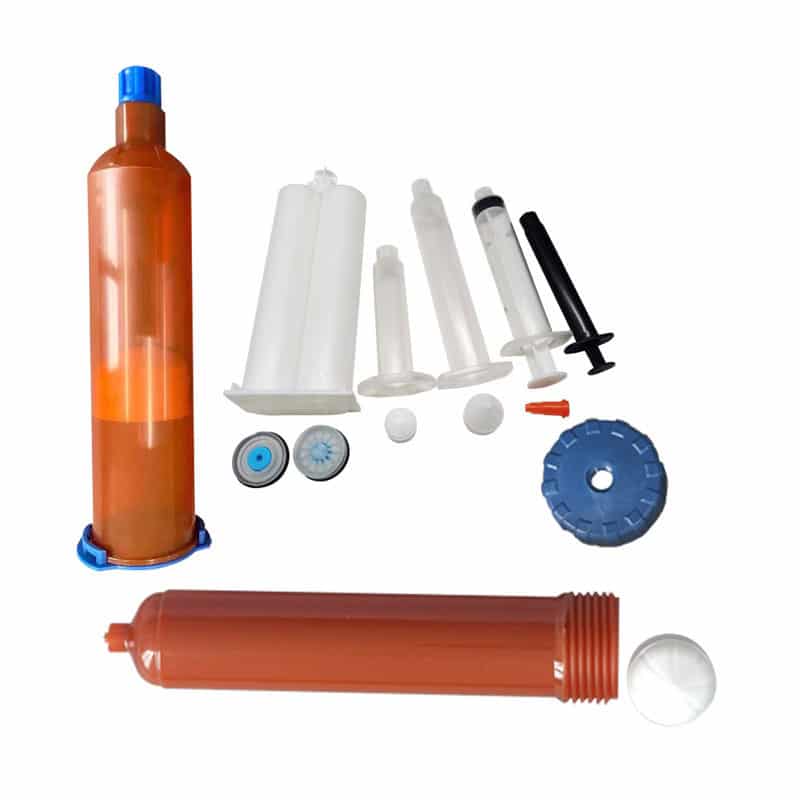Syringe barrel blasts can occur unexpectedly, leading to downtime, material waste, and potential safety hazards. Understanding the root causes of these incidents is crucial for preventing them. Here are some common factors that can contribute to syringe barrel blasts:

1. Excessive Pressure: Applying too much pressure to the syringe barrel, either manually or through a dispensing system, can cause the barrel to burst. This often happens when trying to dispense highly viscous materials that require more force.
2. Blocked Nozzles: A blocked or partially blocked dispensing nozzle can create pressure buildup within the syringe barrel, leading to a blast. It’s essential to regularly check and clean nozzles to prevent this.
3. Incompatible Materials: Using syringe barrels that are not compatible with the materials being dispensed can cause chemical reactions, weakening the barrel and increasing the risk of a blast. Always ensure that the barrel material is suitable for the application.
4. Improper Handling: Rough handling, dropping, or mishandling syringe barrels can weaken them, making them more prone to bursting. Proper care should be taken when using and storing syringe barrels.
5. Temperature Extremes: Extreme temperatures can affect the integrity of syringe barrels, leading to cracks or ruptures. Avoid exposing syringe barrels to temperatures outside of their recommended range.
6. Overfilling: Filling syringe barrels beyond their recommended capacity can put excessive strain on the barrel walls, increasing the risk of a blast. Follow manufacturer guidelines for filling limits.
Importance of Proper Syringe Barrel Maintenance
Proper maintenance of syringe barrels is essential for ensuring their longevity and preventing potential hazards like barrel blasts. Here’s why it’s crucial to maintain your syringe barrels:
Preventing Contamination: Regular cleaning and maintenance of syringe barrels help prevent contamination of the materials being dispensed. Contaminants can lead to clogs, affecting dispensing accuracy and potentially causing barrel blasts.
Ensuring Seal Integrity: The seal between the syringe barrel and the dispensing nozzle is critical for preventing leaks and maintaining pressure stability. Regular inspection and replacement of seals ensure proper sealing, reducing the risk of barrel blasts.
Extending Barrel Lifespan: Proper maintenance, including cleaning and storage in a controlled environment, can extend the lifespan of syringe barrels. This not only saves costs but also reduces the likelihood of barrel failures.
Maintaining Dispensing Accuracy: Clean and well-maintained syringe barrels provide consistent and accurate dispensing, reducing the need for rework and minimizing the risk of overfilling and barrel blasts.
Enhancing Safety: A well-maintained syringe barrel is less likely to fail unexpectedly, reducing the risk of injury to operators and damage to equipment.
Compliance with Regulations: In industries where strict regulations apply, such as medical device manufacturing, proper maintenance of syringe barrels is essential to comply with quality standards and regulations.
Proper Handling and Storage of Syringe Barrels
Proper handling and storage of syringe barrels are critical to prevent damage, contamination, and potential hazards like barrel blasts. Here are some best practices:
Avoid Dropping or Rough Handling: Syringe barrels should be handled with care to avoid cracks or damage to the walls. Dropping or rough handling can weaken the barrel, increasing the risk of a blast.
Use Protective Caps: When not in use, syringe barrels should be capped to prevent contamination and damage to the dispensing tip. Caps also help maintain the integrity of the barrel, reducing the risk of leaks or bursts.
Store in a Controlled Environment: Syringe barrels should be stored in a clean, dry, and temperature-controlled environment to prevent exposure to moisture, extreme temperatures, or contaminants that could compromise their integrity.
Avoid Overcrowding: When storing syringe barrels, avoid overcrowding them to prevent pressure buildup between barrels, which can lead to leaks or blasts.
Inspect Before Use: Before using a syringe barrel, inspect it for any signs of damage, such as cracks, dents, or discoloration. Using a damaged barrel can increase the risk of failure.
Follow Manufacturer Guidelines: Always follow the manufacturer’s guidelines for handling, storage, and maintenance of syringe barrels to ensure their safe and effective use.
Choosing the Right Syringe Barrel for Your Application
Selecting the correct syringe barrel for your dispensing application is crucial for preventing issues like barrel blasts and ensuring optimal dispensing performance. Consider the following factors when choosing a syringe barrel:
Material Compatibility: Ensure that the syringe barrel material is compatible with the adhesive, sealant, or other material you plan to dispense. Using incompatible materials can lead to chemical reactions, weakening the barrel and increasing the risk of a blast.
Size and Capacity: Select a syringe barrel size that matches the volume of material you need to dispense. Overfilling a syringe barrel beyond its capacity can put excessive strain on the barrel walls, increasing the risk of failure.
Dispensing Tip Compatibility: The syringe barrel should be compatible with the dispensing tip you plan to use. Using an incompatible tip can lead to leaks or pressure buildup, increasing the risk of a blast.
Pressure Rating: Consider the pressure rating of the syringe barrel, especially if you are dispensing materials that require higher pressure. Using a syringe barrel with a lower pressure rating than required can lead to failure.
Manufacturer Reputation: Choose syringe barrels from reputable manufacturers known for their quality and reliability. This reduces the risk of using substandard barrels that may be more prone to blasts.
Environmental Factors: Consider the environmental conditions in which the syringe barrel will be used, such as temperature and humidity. Choose a barrel material that can withstand these conditions to prevent failure.
By carefully considering these factors, you can select the right syringe barrel for your application, minimizing the risk of barrel blasts and ensuring efficient dispensing operations.
